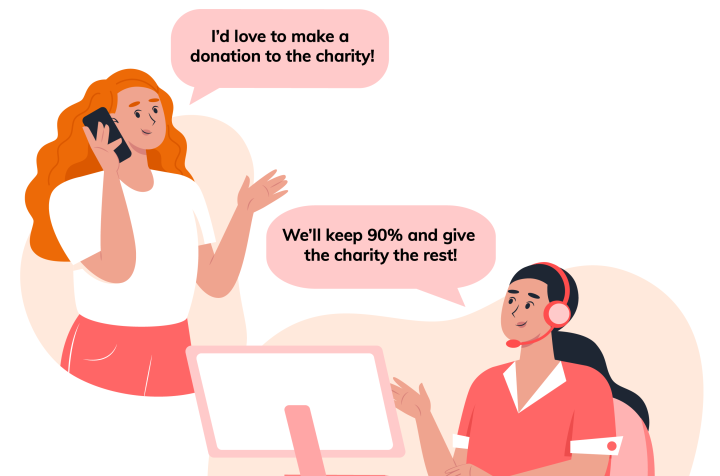
When telemarketers keep 90% of donations

We’re watching the documentary series “Telemarketers” in October. The three-part doc follows a whistleblower investigation that spans nearly two decades, as former call center employees learn their old job was an even bigger scam than they thought. You can stream “Telemarketers” on Max, with a subscription. And you can subscribe here to get the whole series in your inbox.
In the first episode of the “Telemarketers” documentary, Sam Lipman-Stern, one of the film’s protagonists and filmmakers, explains how all the call center workers at Civic Development Group knew that only a small fraction of what people donated actually went to the charities. As much as 90% went instead to the telemarketing company.
That statistic may shock you — it’s supposed to. We’ve repeated it in previous newsletters this month, because it highlights how the telemarketers at CDG reaped disproportionately more benefits from fundraising for charities than the charities themselves.
But how reflective is CDG’s cut of the wider telemarketing industry? Many states require professional fundraisers, including telemarketers, to file reports on how much they’ve raised on behalf of charities and how much actually ended up going to the charities. Those reports show that charities on average retained between 70% and 80% of the donations.
The average, however, hides huge disparities. When Brian Mittendorf, an accounting professor at The Ohio State University, looked at data from his home state, he found that charities retained 81% of funds raised in Ohio in 2020, but charities associated with children’s cancer only retained 12%, and those tied to veterans retained just 13%.
For that same year, charities and fraternal orders associated with police, firefighters and emergency medical services in Ohio retained about 27%. Mittendorf said that he had seen fundraising contracts where 100% of any first-time donation made with a credit card went to the telemarketers.
“The causes that pull most of the heartstrings are the ones that people feel more reluctant to question where the money’s going,” said Mittendorf.
Telemarketers will argue it’s just an economic reality that the service they provide is expensive and inefficient.
“The cost of [telemarketing] has grown disproportionately to the benefit that’s received,” said Michael Thatcher, president and CEO of Charity Navigator, which rates charities based on their effectiveness and transparency. “Folks aren’t answering their phones anymore, so, it is just not as effective as a strategy as it has been in the past.”
But why do some telemarketers charge fees that amount to 80% or 90% of funds raised, when others charge 50% or less? Sarah Kleiner, an independent research consultant who was featured in the “Telemarketers” series, said she has yet to receive a satisfying answer to that question.
“I wish that [you] could look to the law and that it would tell you, ‘X percent is legal and Y percent is not legal’ in terms of how to split fundraising and programs in charitable work,” said Kleiner. “Unfortunately, the Supreme Court has said that states aren’t allowed to do that. So, there isn’t a particular cut off.”
Paying for-profit fundraisers isn’t inherently problematic; outsourcing can help charities focus on their core mission, especially when they don’t have fundraising experts on staff.
“It’s hard for a charity who’s struggling to receive dollars to turn away someone who says ‘We’re going to give you a check every month, is that okay?’” said Mittendorf, “Sometimes charities get caught up in inefficient telemarketing not because of ill intent on their part, but the desire to receive funds.”
So you can’t just say charities that retain a smaller percentage of fundraising funds are a scam and those that retain higher percentages are not. But what percentage a telemarketer keeps can be useful information for donors who want to prioritize the impact of their giving. And anyone who receives a call from a telemarketer on behalf a charity can find out by simply asking the person on the other end of the line.
“[Telemarketers] calling you on the phone are kind of like, counting on two things: One, that you’re going to feel guilty for saying ‘No.’ And two, that you don’t have the time or you don’t know how to research a legitimate charity,” said Kleiner.
In next week’s newsletter, we’ll delve into some practical tips for doing that homework on charities.
Send us your scam stories
Have you ever been scammed, or caught onto a scam before you’d been had? What did you do? What did you learn? We want to hear your stories. Reply to this email or send a note to extracredit@marketplace.org.
There’s a lot happening in the world. Through it all, Marketplace is here for you.
You rely on Marketplace to break down the world’s events and tell you how it affects you in a fact-based, approachable way. We rely on your financial support to keep making that possible.
Your donation today powers the independent journalism that you rely on. For just $5/month, you can help sustain Marketplace so we can keep reporting on the things that matter to you.

















